Although
Sbeitla
is
one
of
the
best
preserved
sites
in
Tunisia,
its
history
is
little
known.
Some
signs,
such
as
the
discovery
of
Punic
stele
and
the
presence
of
megaliths
in
the
area,
indicate
that
life
had
come
early
to
the
region,
though
there
is
no
evidence
of
any
sort
of
urban
life
prior
to
the
arrival
of
the
Romans.
As
far
as
is
known
the
steppes
had
been
inhabited
only
by
nomadic
tribes
until
the
Third
Augustan
Legion
established
a
garrison
at
Ammaedara.
After
the
revolt
led
by
the
Berber
Chief
Tacfarinas,
the
region
was
first
pacified
and
then
developed
by
the
Emperor
Vespasien
and
his
sons.
At
the
same
time
Ammaedara
was
promoted
to
the
rank
of
colony
and
other
towns
in
the
region
were
created
or
developed.
Some
rare
inscriptions
discovered
in
recent
years
suggest
that
the
city
was
the
subject
of
classic
administrative
development
in
the
Roman
Province
of
Ifriqiya.
The
expansion
of
the
olive
oil
industry
[the
climate
was
perfect
for
the
production
of
olives,
the
staple
diet
of
Rome's
legions]
ensured
the
prosperity
of
the
town
from
the
second
century
B.C.,
and
provided
the
finance
for
the
construction
of
a
splendid
forum.
This
prosperity
would
seen
to
have
continued
during
the
3rd
and
4th
centuries,
even
though
this
was
a
period
of
decline
the
approval
of
the
Emperors
to
establish
the
bishoric
in
Sbeitla,
which,
according
to
chroniclers
of
that
era,
was
captured
and
pillaged.
It
would
seem
that
the
town's
fortunes
declined
after
these
events,
and
continued
to
vegetate
until
the
whole
of
Tunisia
was
finally
conquered
by
the
Arabs.
During
the
centuries
which
followed
the
conquest
urban
life
in
Sbeitla
deteriorated
to
such
an
extent
that
the
land
eventually
returned
to
its
nomadic
origins.
The
Antonine
Gateway
The
gateway
to
the
Forum
can
be
dated
[138-161
A.D.]
thanks
to
an
inscription
which
refers
to
the
Emperor
Antonius
Pious
and
his
two
adopted
sons,
Marcus
Aurelius
[the
future
Emperor
and
philosopher]
and
Licius
Verus.
The
gateway,
built
in
the
style
of
an
arch
of
triumph,
forms
part
of
the
ancient
walls,
though
of
a
lesser
thickness.
The Forum
This is a vast, almost square, esplanade paved with stone slabs; it is surrounded by a wall against which stand halls or large rooms [each fronted by a covered portico supported by colonnades], though the use to which these were put has never been clearly established. Over the centuries the square was enlarged and the walls restored several times.
The Three Temples
Although there is no inscription to indicate to whom they were dedicated, it is generally assumed that this was a Capitol dedicated to the three divinities of the official Roman Pantheon, Jupiter, Juno and Minerva. Instead of building a single temple divided into three chapels or niches [as, for example, one finds at Dougga], the builders at Sbeitla conceived a far more grandiose project for their town and built a temple for each divinity. It was something which, to our knowledge [and given the cost of the project], was only attempted once elsewhere. To give unity to the ensemble the central temple was fronted by a tribune without steps, and one acceded to the central temple through the two lateral temples; one can easily imagine the scared processions moving from each extremity of the forum and symmetrically converging on the central temple, which was more opulently decorated and adorned than the other two.
The Church of Bellator
As is often the case on ancient sites, this church was erected on a building dating from an earlier period. Modest enough in its proportions and decorations, it has two apses and a baptistery converted into a chapel dedicated to the Catholic Bishop Jucundus, who lived here in the early fifth century and, it is generally believed, was martyred by the Arian Vandals.
The Church of Vitalis
Immediately adjacent to the Church of Bellator is another, larger, Catholic Basilica, again with two apses. Behind one of these is a baptistery decorated with mosaics.
The Church of Servus the Priest
This was built in the courtyard of an ancient pagan sanctuary, while the temple itself harbours the baptistery. It is possible that this was the Donatist Cathedral or, in any event, that of some other non-Catholic sect.
Fountains
Sbeitla has three public fountains dating from the 4th century. The best of these is situated close to the Forum; the basin of the fountain is enclosed at the back and on each side by a colonnade. The second fountain adjoins the Church of Servus and the third [which was converted into a dwelling at some time during the dark ages] is on the road which leads to the amphitheatre.
The Theatre
Even though the theatre is in a poor state of preservation it is worth a detour, as much for its picturesque location as anything else, since it stands on the Oued Sbeitla ravine. The tiers are in a state of ruin but the orchestra pit is still clearly visible, as are some of the colonnades around the stage, which drops away towards the ravine. Fine view of the escarpments of the oued, which is dry for most of the year, but which can become a raging torrent.
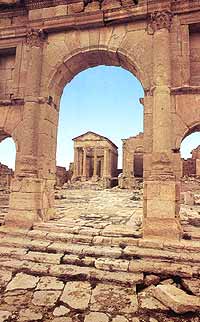
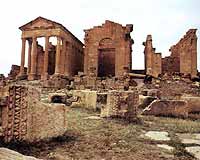
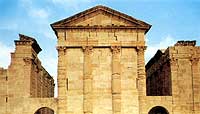
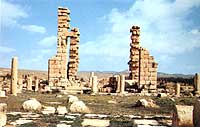
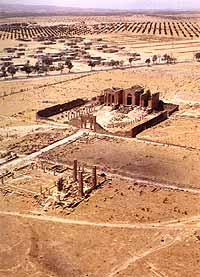
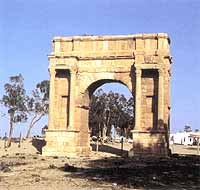
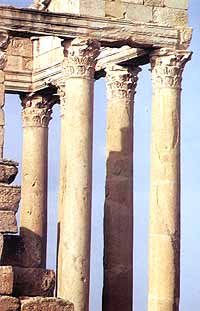
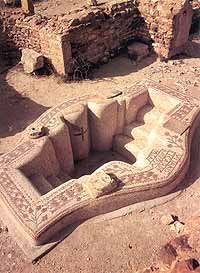
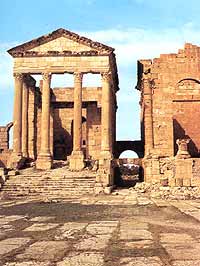
The Main Baths
These were built close to the theatre. They have nothing of the symmetry one usually expects to find. There are two caldaria, identifiable by the hypocaust below the floors, though the two rooms are not on the same level nor on the same axis. The disposition of the frigidaria, too, irregular, and it is obvious that the building was altered at some time. Some of the rooms are decorated with colourful mosaics.
The Small Baths
These are situated just to the north of the Church of Servus. Considerably smaller than the main baths they have fallen into a poor state of preservation.
The Amphitheatre
Though poorly preserved, they have not yet been fully excavated. The former inhabitants of Ifriqiya, great lovers of the games in the arena, reinforced the building with stone - some of which bears inscriptions - taken from the forum. It is possible that this amphitheatre, too, served as an improvised refuge and fortress.
The Forts
During
the
Byzantine
period
a
series
of
small
forts,
intended
to
serve
as
shelters
for
the
population,
were
built
along
the
road
which
leads
to
the
arch
of
triumph
built
in
honour
of
the
Terarchy.
They
consist
of
a
walled
door
less
enclosure,
the
only
access
to
which
was
by
ladder.
The
interior
was
divided
into
rooms,
and
there
was
a
well
to
ensure
adequate
supplies
of
water
during
a
siege.
The Arch of Triumph to the Tetrarchy
An imposing mass, part of which consists of baldaquins supported by columns. The decor is quite sumptuous and the arch itself somewhat irregular. It was built in honour of the four Emperors (the Tetrarchate) who jointly ruled the Empire around 300 A.D., just prior, that is, to the reign of Constantine the Great.
EGYPT - SYRIA - JORDAN